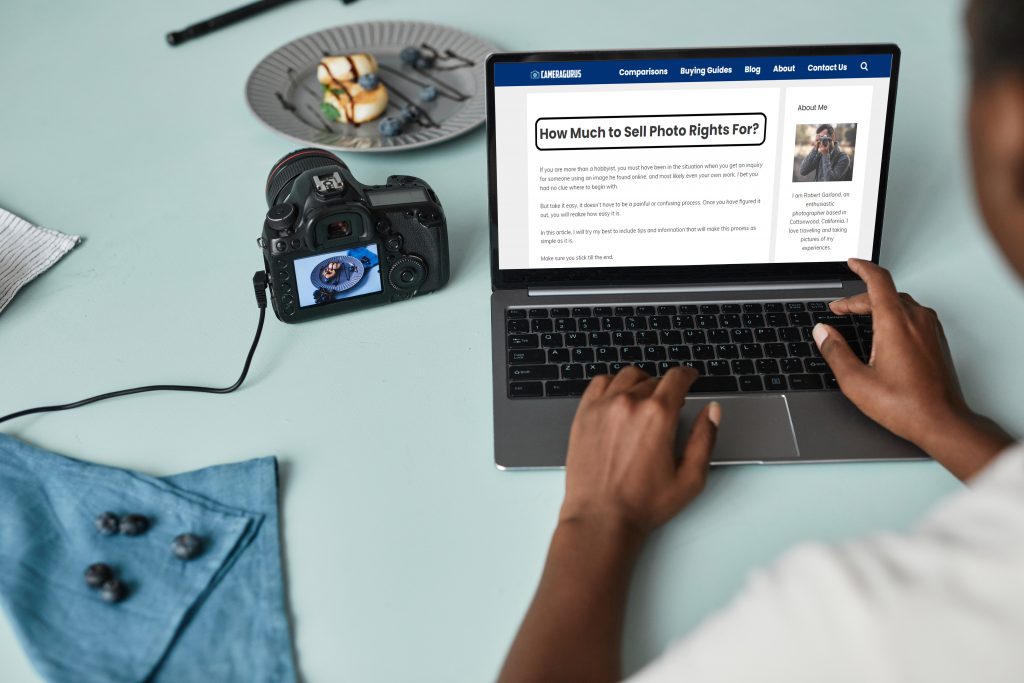
If you want to level up your photography work and take things to the next stage by selling your photos or exactly your photo rights, you came to the right place.
After all, you need some extra cash to purchase that expensive lens.
In today’s article, I will be writing on how to sell your photo rights.
Before we move on to online selling and all that, I will start by sharing some information on how to sell your photos locally.
Selling Personally and Locally
Well, I am well aware that this is an old-fashioned way and we live in a modern technology world now, where everything happens online.
But, if you live in a small town, like me, people tend to keep things old school out here. Especially, if you are known, a friend might refer you to a local business.
They will ask you to take some pictures for their project/needs or sell some of your current work.
How Much Should You Charge for Your Photos?
If you are doing a face-to-face business, it is not wrong nor disrespectful to ask for a price.
You can do it in a friendly manner and ask the opposite, how much is their budget and how much they are willing to spend.
However, this is a tricky thing and depends on a lot of factors; your time spent, the quality of the photos, and the standards of your country.
If the average is around $50, you can’t ask for more; yes, I know your work is good, and you spent time after-editing and all that; if that is the standard in your hometown, you have to obey that.
Consulting Your Peers
If you are quite new to photography and have no clue how things go around in the photography world, do not hesitate to ask fellow photographers.
They will help you and show how things go around, or even possibly price your photos.
Just remember though, “Don’t bite the hand that feeds you”.
What I mean by this, is even if you get known locally and get a lot of work, don’t undercut your competitors, just so you can beat them.
You will damage yourself and your peers in the long run, you will get nothing out of it.
Newspaper and Magazines
This also goes on the online aspect and not just locally. If a newspaper, TV station and a Magazine ask to buy your photo, that’s a great opportunity for you.
We all are aware that they have a great influence in marketing, they can get you known in no time, which will breed even more work for you in return.
Besides all that, you can get hired to be one of their photographers and keep the “hustle” going.
Licensing Your Photos and Selling Online:

Royalty-Free
Now moving to the online part a great way to start with selling your photos would be the Royalty-Free method.
You can share your work/photos on Royalty-Free websites so you can gradually pick a pace and make a name out of yourself.
If someone likes your work, he will have to pay a one-time fee to get the rights to use the image and he will be able to use it as many times as he wants it.
Simply put, he won’t have to pay you every time he uses the image, but this doesn’t mean that your work is copyright free either, he just bought the right to use the picture that’s all.
Stock Photography
You probably heard the term stock photography, or even encounter a lot of images that are watermarked, with something like “stock”
Stock photos are images that are on sale for a range of purposes, be it for business or even personal use.
There are tons of stock photography websites out there and day by day this method is becoming more and more popular.
First, you pick the website that you want to share your work with, they agree to upload it and after someone who likes your work, has to pay a fee to use your images for his own needs.
The acquiring stock website will get the rights to use the photos from you, but still, the copyright of your work will remain to you. So you can withdraw it whenever you want.
Below, I will list some very popular websites that will help you with this.
- Shutterstock
- Storyblocks
- Envato Elements
- iStock
Let’s say you decide to use Shutterstock, you go and read their terms and requirements after you upload your content and you are done.
You will be getting paid for every time the photo you uploaded gets downloaded.
Regarding payments and how much you can earn, I would advise checking Shutterstock officially.
Pretty much the same goes for the rest of the stock photography websites.
Selling Print Photos
Selling print photos open a way of versatility, since you offer customers a digital and print photo.
There are a lot of companies, or businesses that might want some printed photos to use for their projects, or even students might need them.
The thing with the print photos is that the competition is pretty high. If you are confident in your work and you think that you are unique among the huge number of photographers who dived in this market, no one is stopping you from doing so.
I believe in you!
Via Your Own Website
Another great method would be setting up your own website and sharing your work there.
First, you set up your website, make sure you find an attractive name for it, make the website look good, and upload your work there. Price your content by how much you think it would cost.
Or you can even offer subscriptions and such, but that’s another matter.
While selling the photos via your own website might increase your profits since you get rid “of the middle man” and all the earnings go to you, it comes with another burden.
You will have to do all the work yourself, marketing, advertising the website, trying to get people to work with you, etc. Even though there is a lot of work involved here if you are confident you can do it.

Final Words:
While I can’t give you a ballpark figure on how much you should sell your photo rights, I can tell you some ways, and I did mention the best ones above.
Thanks to modern technology and the crowded market, there are many ways to make money for photographers.
Long gone are the days when they were forced to take photos only for magazines.

Photo & Videographer
A photographer with a passion for capturing the beauty of nature and the human form. My work has been featured in galleries and publications around the world, and I strive to create images that evoke emotion and tell a story.



